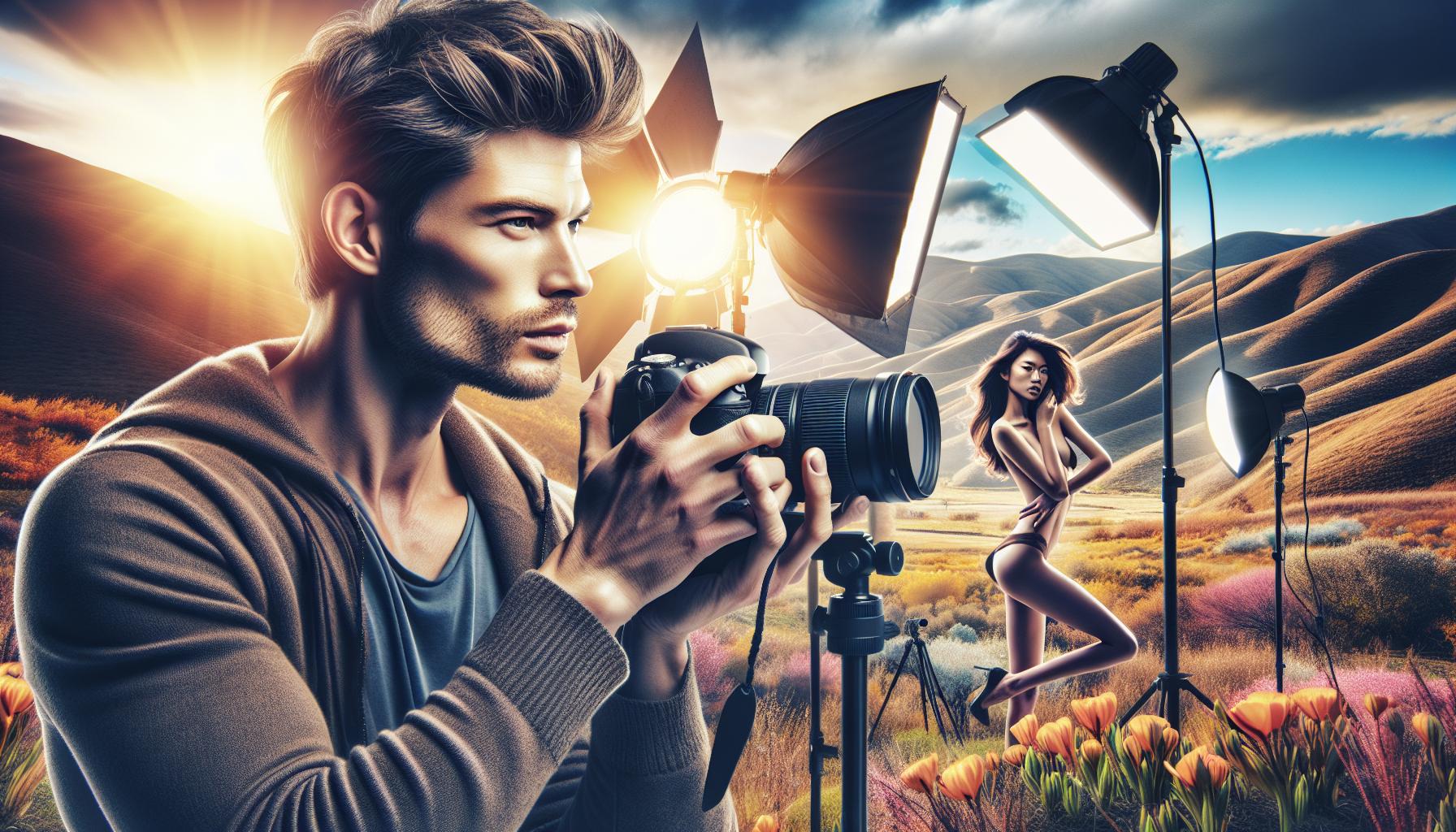Off-camera flash (OCF) photography opens up a world of creative possibilities that on-camera flash just can’t match. It’s like giving a painter an entirely new palette of colors to work with – suddenly every shadow and highlight becomes a creative choice rather than a technical limitation.
Photography enthusiasts who’ve mastered natural light often find themselves hitting a wall when the sun sets or when indoor lighting proves challenging. That’s where OCF steps in, transforming ordinary scenes into extraordinary images with professional-grade lighting that’ll make viewers wonder “How’d they do that?” From dramatic portraits to dynamic event coverage, OCF has become the secret weapon of photographers who want their work to stand out in today’s competitive visual landscape.
OCF Photography
Off-camera flash photography involves positioning one or more flash units away from the camera to create directional lighting effects. This technique separates the light source from the camera’s position, enabling photographers to shape light creatively.
Key Equipment Needed for OCF
- Flash Unit: A speedlight or strobe with wireless capabilities
- Wireless Triggers: Radio transmitters and receivers to sync the flash with the camera
- Light Modifiers: Softboxes, umbrellas or grids for controlling light spread
- Light Stands: Adjustable stands to position flashes at various heights and angles
- Mounting Brackets: Cold shoe mounts and adapters to secure flash units
- Batteries: Rechargeable batteries for flash units and triggers
- Flash Meter: A device to measure light output and ensure proper exposure
- Creates depth through controlled shadows and highlights
- Produces professional-grade portraits in challenging lighting conditions
- Enables consistent exposure across multiple shooting locations
- Adds dimension to flat scenes through strategic light placement
- Separates subjects from backgrounds using rim lighting techniques
- Balances ambient light with artificial illumination
- Controls reflections and specular highlights on shiny surfaces
- Freezes motion with high-speed sync capabilities
- Maintains image quality in low-light environments
- Opens creative possibilities for dramatic lighting effects
Understanding Flash Power and Settings
Flash power control determines the intensity of artificial light in off-camera flash photography. The correct settings create balanced exposures while achieving desired creative effects.
Manual vs TTL Flash Control
Manual flash control gives photographers complete power over light output through specific fractional settings (1/1, 1/2, 1/4, down to 1/128). TTL (Through The Lens) metering automatically adjusts flash output based on camera-measured exposure requirements. Manual mode delivers consistent results across identical shooting conditions, making it ideal for studio work or controlled environments. TTL excels in dynamic situations with changing subject distances or lighting conditions, such as event photography or photojournalism.
Key differences:
- Manual: Fixed output regardless of subject distance
- TTL: Adjusts power based on subject reflection
- Manual: Requires more setup time but offers precise control
- TTL: Provides faster shooting response with variable accuracy
Flash Sync Speed Basics
Flash sync speed represents the fastest shutter speed that synchronizes with flash illumination. Most cameras feature sync speeds between 1/160 to 1/250 of a second. Higher shutter speeds create a black band across images due to mechanical shutter limitations.
Common sync speed applications:
- Balancing ambient light outdoors (1/160 – 1/250)
- Studio portraits (1/125 – 1/160)
- Action freezing with HSS (High-Speed Sync)
- Light painting at slower speeds (1/60 or below)
HSS enables flash use above standard sync speeds but reduces flash power output significantly. This feature proves essential for shallow depth of field shots in bright conditions.
Positioning Your Off-Camera Flash

Effective off-camera flash placement transforms ordinary photographs into compelling images. The position of the flash unit relative to the subject determines the quality, direction, and intensity of light.
Using Light Modifiers
Light modifiers shape harsh flash output into controlled illumination patterns. Softboxes diffuse light across broader surfaces, creating gradual transitions between highlights and shadows. Umbrellas spread light in a circular pattern, offering quick setup for event photography. Beauty dishes produce focused yet flattering light with distinctive circular catchlights, ideal for portrait photography. Grid attachments restrict light spread to specific areas, enabling precise control for dramatic effects. Snoots concentrate light into narrow beams for accent lighting or hair highlights. Gels alter flash color temperature to match ambient lighting conditions or create artistic effects.
Common OCF Lighting Patterns
Rembrandt lighting positions the flash 45 degrees above the subject’s face, creating a triangular highlight on the shadowed cheek. Loop lighting places the flash slightly above eye level at a 45-degree angle, producing a small shadow beneath the nose. Split lighting divides the face into equal light and shadow sections by positioning the flash perpendicular to the subject. Butterfly lighting mounts the flash directly above the subject, casting a symmetrical shadow beneath the nose. Broad lighting illuminates the side of the face closest to the camera, while short lighting emphasizes the far side for slimming effects.
Creative OCF Techniques

Off-camera flash techniques unlock advanced creative possibilities in photography. These methods transform ordinary scenes into compelling visual narratives through strategic light placement and manipulation.
Balancing Flash with Ambient Light
Balancing flash with ambient light creates natural-looking images that blend artificial and existing light sources seamlessly. Setting the camera’s exposure for the background establishes the foundation for proper ambient light capture. The flash power adjusts to match the subject’s illumination with the surrounding environment, typically starting at 1/16th power. A light meter helps achieve precise ratios between flash and ambient light, maintaining a 2:1 or 3:1 lighting ratio for optimal results. Photographers use neutral density filters to control ambient light while maintaining flash exposure in bright conditions.
Adding Drama with Multiple Flashes
Multiple flash setups create depth and dimension through layered lighting effects. A key light establishes the primary illumination while rim lights separate subjects from backgrounds. Cross-lighting techniques position two flashes at 45-degree angles to produce dramatic shadows and highlights. Color gels on secondary flashes add atmosphere through complementary or contrasting temperature effects. Photographers stack flashes in groups to increase power output for large scenes or to overcome bright ambient conditions. Remote triggers with multiple channels enable independent control of each flash unit’s power settings.
Common OCF Photography Mistakes to Avoid
- Incorrect Flash Power Settings
- Setting flash power too high creates harsh shadows on subjects
- Underestimating flash output results in underexposed images
- Using inconsistent power levels across multiple flashes disrupts lighting balance
- Poor Flash Positioning
- Placing flashes at eye level creates flat lighting
- Setting lights too close causes hot spots on subjects
- Positioning flashes behind reflective surfaces creates unwanted glare
- Inadequate Light Modification
- Using bare flash produces harsh direct light
- Selecting wrong-sized modifiers for the subject distance
- Failing to secure modifiers properly leads to light spill
- Sync Speed Errors
- Exceeding camera’s sync speed creates dark bands
- Not enabling HSS for outdoor daylight portraits
- Mismatching shutter speed with ambient light conditions
- Technical Oversights
- Dead batteries in remote triggers during shoots
- Incorrect radio channel settings between transmitter receiver
- Missing backup equipment for critical components
- Light Ratio Imbalance
- Overpowering ambient light creates unnatural looks
- Ignoring background exposure relative to subject
- Failing to meter each light source independently
- Equipment Stability Issues
- Using lightweight stands in outdoor conditions
- Improper sandbag usage on light stands
- Neglecting safety cables for elevated equipment
- Color Temperature Conflicts
- Mixing flash with uncorrected ambient light
- Incorrect white balance settings for flash
- Inconsistent gel usage across multiple lights
These mistakes impact image quality directly through improper exposure incorrect lighting ratios unwanted shadows color inconsistencies. Photographers improve OCF results by addressing these technical creative considerations systematically.
Best Camera Settings for OCF Photography
Optimal camera settings for off-camera flash photography start with manual mode to maintain complete control over exposure variables. Manual settings include:
- Aperture: f/5.6 to f/8 for portrait sessions
- Shutter speed: 1/160 to 1/200 for standard sync
- ISO: 100 or 200 for minimal noise
- White balance: 5500K for consistency with flash output
Flash power settings correlate directly with these camera parameters:
| Distance to Subject | Flash Power | Aperture |
|---|---|---|
| 3-5 feet | 1/16 – 1/8 | f/5.6 |
| 6-8 feet | 1/4 – 1/2 | f/8 |
| 9-12 feet | 1/2 – Full | f/11 |
Key exposure combinations for different scenarios include:
- Indoor portraits: 1/160 sec, f/5.6, ISO 100
- Event photography: 1/200 sec, f/4, ISO 400
- Product shoots: 1/125 sec, f/8, ISO 100
- Environmental portraits: 1/200 sec, f/4, ISO 200
Focus settings affect flash exposure through:
- Single point AF for precise subject focus
- Back button focus for consistent focus points
- AF assist beam activation in low light conditions
- Focus priority over release in single shot mode
These settings create a foundation for consistent OCF results while maintaining flexibility for creative adjustments based on specific lighting scenarios.
Off-camera flash photography stands as a game-changing technique that elevates ordinary photos into extraordinary works of art. When photographers master OCF they unlock endless creative possibilities while gaining the technical skills to handle any lighting situation with confidence.
The journey to OCF mastery requires understanding equipment settings lighting patterns and common pitfalls. But the rewards are worth the effort. Armed with this knowledge photographers can create stunning professional-quality images that stand out in today’s competitive market.
Whether capturing portraits events or creative concepts OCF empowers photographers to take control of their lighting and craft images exactly as they envision them. It’s a skill that transforms good photographers into exceptional visual artists.




